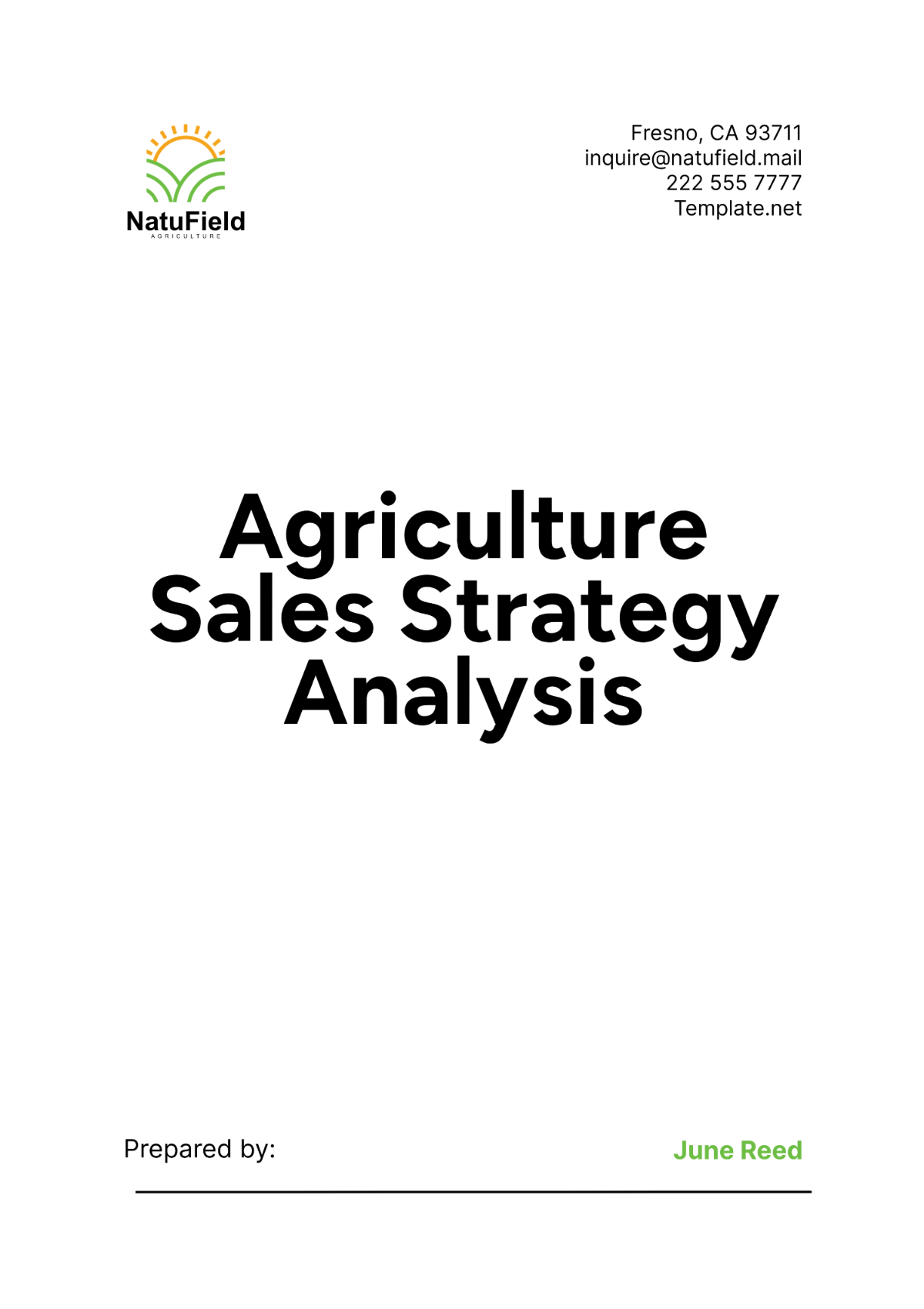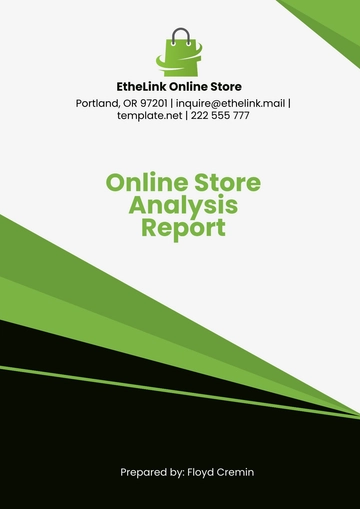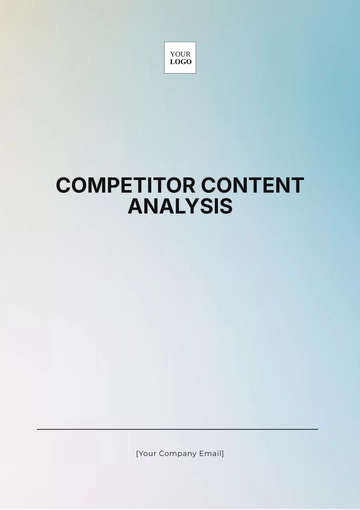Free Agriculture Sales Strategy Analysis

I. Executive Summary
In the dynamic agriculture industry, [Your Company Name] is committed to strengthening our sales strategy to enhance market presence and achieve sustained growth. This analysis outlines our approach to capturing market opportunities, leveraging our product strengths, and addressing customer needs. Our primary focus is to optimize our sales processes, expand our customer base, and increase revenue.
Key Goals
Achieve a 20% increase in sales revenue within the next fiscal year.
Expand market share by 15% through targeted marketing and sales initiatives.
Enhance customer satisfaction and retention rates by 10%.
Develop and implement a comprehensive sales training program for our team.
Increase online sales by 25% through improved digital sales strategies.
II. Market Overview
The agriculture industry is experiencing significant growth, driven by advancements in technology and increasing demand for sustainable farming practices. According to recent reports, the global agriculture market is projected to reach $12.5 trillion by 2050, with a compound annual growth rate (CAGR) of 6.7%. Key trends influencing the market include the adoption of precision farming techniques, the rise of organic farming, and the growing importance of food security.
Technological innovations, such as the use of drones, IoT devices, and artificial intelligence, are transforming traditional farming methods, leading to increased efficiency and productivity. Additionally, consumer demand for transparency and sustainability in food production is prompting agricultural businesses to adopt more environmentally friendly practices. This evolving landscape presents numerous opportunities for growth and innovation within the industry.
III. Product Analysis
We offer a diverse range of products designed to meet the needs of modern agricultural practices. Our product portfolio includes:
Precision Farming Equipment: Advanced tools and machinery for accurate soil analysis, crop monitoring, and resource management.
Organic Fertilizers: Eco-friendly fertilizers that enhance soil health and promote sustainable farming.
Irrigation Systems: Efficient irrigation solutions tailored to various crop requirements and climatic conditions.
Crop Protection Products: Safe and effective pesticides and herbicides to protect crops from pests and diseases.
Agri-Tech Solutions: Innovative software and IoT devices for data-driven farming and real-time monitoring.
Our unique selling proposition (USP) lies in our commitment to sustainability and innovation. We differentiate ourselves by offering high-quality, eco-friendly products that not only enhance farm productivity but also promote long-term environmental health. Our focus on cutting-edge technology ensures that our customers have access to the latest advancements in agricultural practices, positioning us as a leader in the industry.
IV. Target Market
Our target market comprises various segments within the agriculture sector, each with distinct demographics and needs. The following table provides an overview of our key customer segments:
Demographic | Age Range | Needs |
|---|---|---|
Small-Scale Farmers | 25-55 | Affordable, easy-to-use technology |
Large Agribusinesses | 35-65 | Scalable solutions for efficiency |
Organic Farmers | 30-50 | Eco-friendly, sustainable products |
Agri-Tech Enthusiasts | 20-40 | Innovative, data-driven farming solutions |
These segments highlight the diverse needs of our customers, ranging from affordability and ease of use to sustainability and technological innovation. By addressing these specific needs, we can effectively tailor our sales strategies to each segment.
V. Competitive Analysis
Understanding our competitive landscape is crucial for refining our sales strategy. The following table highlights key competitors in the market:
Competitor | Market Share | Strengths | Weaknesses |
|---|---|---|---|
30% | Strong brand recognition | Limited innovation | |
25% | Advanced technology | High operational costs | |
20% | Robust network | Lower product quality | |
15% | Strong online presence | Smaller market share |
Our position in the market is strengthened by our commitment to sustainability and innovation, differentiating us from competitors who may lack these focus areas. While some competitors have strong brand recognition and extensive product ranges, we leverage our technological advancements and eco-friendly products to meet the evolving needs of our customers. By emphasizing our unique value propositions and continuously improving our offerings, we are well-positioned to capture a larger share of the market and achieve our sales objectives.
VI. Sales Objectives
Our sales objectives are designed to drive growth, enhance customer satisfaction, and expand our market presence. These objectives will guide our sales team in achieving measurable and impactful results. We aim to:
Increase overall sales revenue by 20% within the next fiscal year.
Expand our customer base by acquiring 100 new clients in market segments.
Improve customer retention rates by 10% through enhanced support.
Achieve a 25% growth in online sales by optimizing our digital sales strategies.
Boost market share by 15% by leveraging strategic partnerships and innovative solutions.
VII. Sales Strategies
A. Direct Sales
Our direct sales strategy focuses on building strong, personalized relationships with our customers. Tactics include:
Conducting on-site visits and product demonstrations to showcase the benefits and functionality of our offerings.
Developing customized sales proposals that address specific customer needs and pain points.
Offering flexible pricing models and payment plans to accommodate diverse customer budgets.
B. Channel Sales
Channel sales involve leveraging partnerships with distributors, retailers, and other intermediaries to expand our reach. Tactics include:
Establishing and nurturing relationships with key channel partners to ensure alignment with our sales goals.
Providing comprehensive training and support to channel partners to enhance their product knowledge and sales capabilities.
Implementing incentive programs to motivate channel partners and drive sales performance.
C. Digital Sales
Digital sales strategies are crucial for reaching tech-savvy customers and expanding our online presence. Tactics include:
Enhancing our e-commerce platform to provide a seamless and user-friendly shopping experience.
Utilizing search engine optimization (SEO) and pay-per-click (PPC) advertising to drive targeted traffic to our website.
Implementing personalized marketing campaigns based on customer data and behavior to increase conversion rates.
D. Inbound Sales
Inbound sales focus on attracting potential customers through value-driven content and engagement. Tactics include:
Creating high-quality, informative content such as blog posts, videos, and webinars that address customer needs and interests.
Utilizing social media platforms to engage with our audience, share insights, and respond to inquiries.
Implementing lead nurturing workflows to guide prospects through the sales funnel and build trust.
E. Outbound Sales
Outbound sales involve proactive outreach to potential customers to generate leads and close deals. Tactics include:
Conducting targeted email campaigns and cold-calling initiatives to reach high-potential prospects.
Participating in industry events, trade shows, and networking opportunities to identify and connect with potential clients.
Developing a robust follow-up process to maintain contact with leads and move them through the sales funnel.
VIII. Sales Process
A. Sales Funnel
The sales funnel represents the stages from initial contact to closing a sale. Each step requires specific actions to guide prospects towards making a purchase. Key stages include awareness, interest, consideration, intent, and purchase.
B. Lead Generation
Lead generation involves identifying and attracting potential customers. Tactics include leveraging online marketing, attending industry events, and utilizing referral programs. The goal is to build a robust pipeline of qualified leads.
C. Lead Qualification
Lead qualification is the process of evaluating leads to determine their potential as customers. Criteria such as budget, authority, need, and timeline (BANT) are used to prioritize leads. Qualified leads are then passed to the sales team for further engagement.
D. Sales Pitch
The sales pitch is a tailored presentation that addresses the specific needs and challenges of the prospect. It highlights the benefits and unique selling points of our products, demonstrating how they can solve the prospect's problems and add value to their operations.
E. Closing Techniques
Closing techniques are strategies used to finalize the sale and secure a commitment from the prospect. Techniques include addressing objections, offering incentives, and creating a sense of urgency. Effective closing ensures the transition from prospect to customer.
IX. Sales Team
Our sales team is structured to maximize efficiency and effectiveness in achieving our sales goals. Each role is clearly defined to ensure accountability and collaboration.
Role | Responsibilities |
|---|---|
Sales Manager | Overseeing sales strategy implementation |
Account Executive | Managing client relationships, closing deals |
Sales Representative | Generating and qualifying leads |
Sales Support | Assisting with administrative tasks, customer inquiries |
Marketing Coordinator | Aligning marketing and sales efforts, content creation |
To motivate and reward our sales team, we offer a comprehensive incentive program. This includes performance-based bonuses, commission structures, and recognition awards for outstanding achievements. Regular training sessions and professional development opportunities are provided to enhance skills and foster career growth. By investing in our team's success, we ensure sustained high performance and a motivated sales force.
X. Performance Metrics
To ensure the success of our sales strategy, we will track key performance metrics that provide insights into our progress and effectiveness. These metrics will help us identify areas for improvement and make data-driven decisions.
Metric | Target Value |
|---|---|
Sales Revenue Growth | 20% increase |
New Customer Acquisition | 100 new clients |
Customer Retention Rate | 10% improvement |
Online Sales Growth | 25% increase |
Market Share Expansion | 15% increase |
These metrics will be monitored using our Customer Relationship Management (CRM) system, sales analytics tools, and regular performance reports. The sales team will review these metrics in weekly meetings, and management will conduct monthly and quarterly evaluations to ensure alignment with our goals and make necessary adjustments.
XI. Budget and Resources
Effective allocation of budget and resources is critical to executing our sales strategy. The following table outlines our budget breakdown for key sales activities and resource allocation:
Activity | Budget Allocation |
|---|---|
Direct Sales | $100,000 |
Channel Sales | $50,000 |
Digital Sales | $75,000 |
Inbound Marketing | $50,000 |
Outbound Marketing | $75,000 |
Sales Training | $25,000 |
Technology and Tools | $50,000 |
Total | $425,000 |
These resources will be allocated strategically to ensure each aspect of our sales strategy is adequately supported, enabling us to achieve our objectives effectively.
XII. Risk Management
Identifying and mitigating risks is essential for the successful implementation of our sales strategy. The following table highlights key risks, their likelihood, impact, and the mitigation strategies in place:
Risk | Likelihood | Impact |
|---|---|---|
Market Fluctuations | Medium | High |
Competitor Actions | High | Medium |
Technological Failures | Low | High |
Supply Chain Disruptions | Medium | High |
Regulatory Changes | Low | Medium |
We have established comprehensive mitigation strategies to address these risks. Regular risk assessments and contingency planning will be conducted to ensure we are prepared to handle any potential challenges effectively.
XIII. Implementation Plan
The implementation plan outlines the key milestones, timelines, and responsibilities necessary for executing our sales strategy. The following table provides an overview of our action plan:
Milestone | Timeline | Responsibility |
|---|---|---|
Sales Strategy Kickoff | Sales Manager | |
Sales Team Training | Training Coordinator | |
Launch Digital Sales Campaign | Marketing Coordinator | |
Establish Channel Partnerships | Channel Manager | |
Evaluate Initial Results | Sales Manager | |
Adjust Strategy as Needed | Sales Team | |
Achieve First Quarter Targets | Sales Manager | |
Mid-Year Review and Adjustments | Senior Management |
XIV. Evaluation and Adjustment
To maintain the effectiveness of our sales strategy, we will conduct regular reviews and evaluations. These reviews will take place on a monthly, quarterly, and annual basis. Monthly reviews will focus on immediate performance and adjustments, quarterly reviews will assess broader trends and progress toward targets, and annual evaluations will guide strategic planning for the following year. This continuous evaluation process ensures that our sales strategy remains dynamic and responsive to changing market conditions.
- 100% Customizable, free editor
- Access 1 Million+ Templates, photo’s & graphics
- Download or share as a template
- Click and replace photos, graphics, text, backgrounds
- Resize, crop, AI write & more
- Access advanced editor
Explore Template.net's Agriculture Sales Strategy Analysis Template, fully editable and customizable in our AI Editor tool. Analyze and refine sales strategies for optimal agricultural business growth. Ideal for identifying market opportunities and maximizing sales effectiveness in the agricultural sector.





























